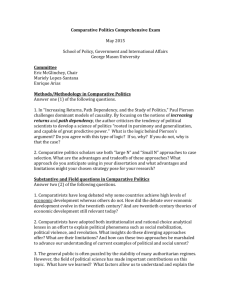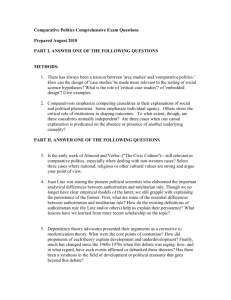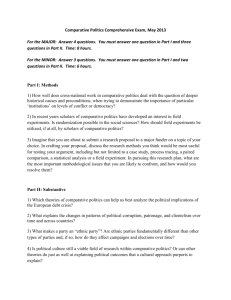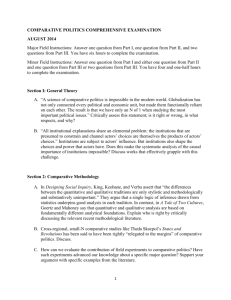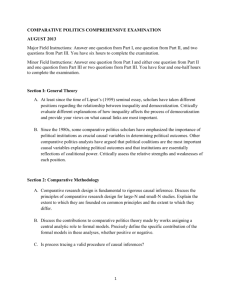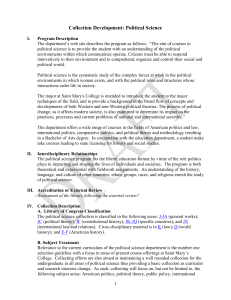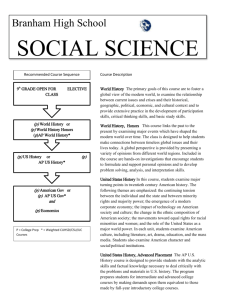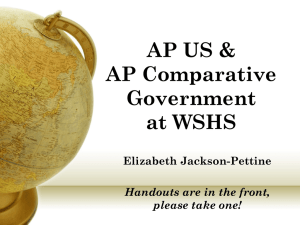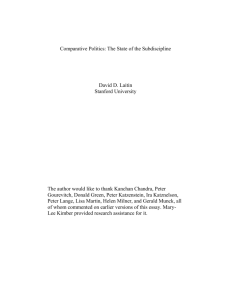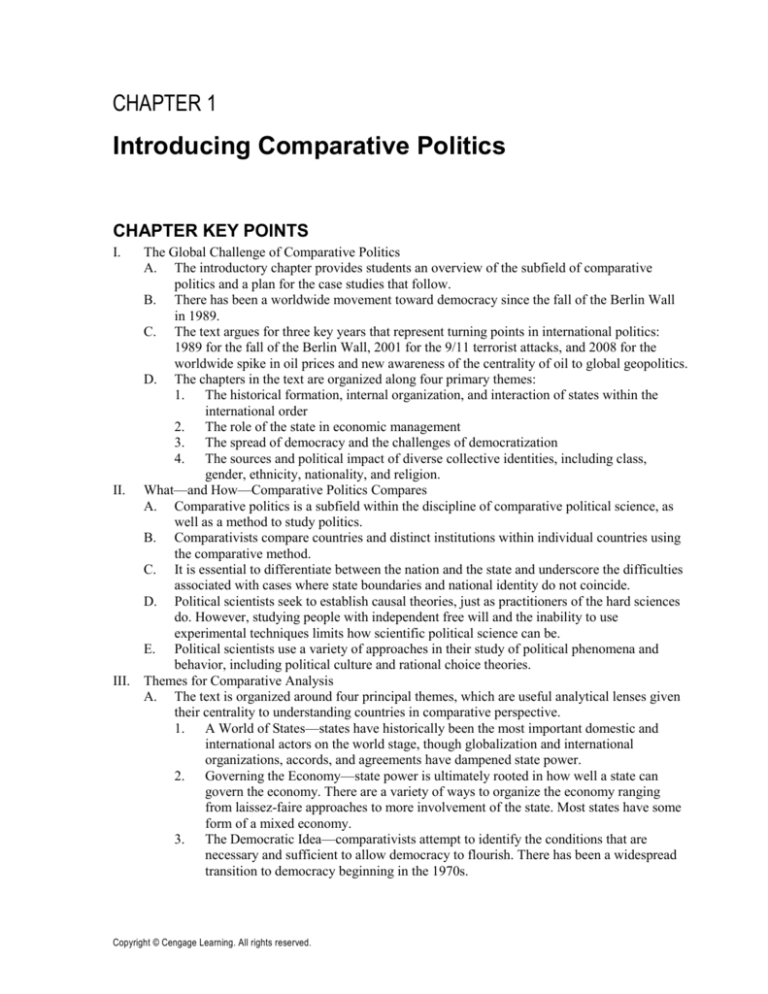
CHAPTER 1
Introducing Comparative Politics
CHAPTER KEY POINTS
I.
The Global Challenge of Comparative Politics
A. The introductory chapter provides students an overview of the subfield of comparative
politics and a plan for the case studies that follow.
B. There has been a worldwide movement toward democracy since the fall of the Berlin Wall
in 1989.
C. The text argues for three key years that represent turning points in international politics:
1989 for the fall of the Berlin Wall, 2001 for the 9/11 terrorist attacks, and 2008 for the
worldwide spike in oil prices and new awareness of the centrality of oil to global geopolitics.
D. The chapters in the text are organized along four primary themes:
1. The historical formation, internal organization, and interaction of states within the
international order
2. The role of the state in economic management
3. The spread of democracy and the challenges of democratization
4. The sources and political impact of diverse collective identities, including class,
gender, ethnicity, nationality, and religion.
II. What—and How—Comparative Politics Compares
A. Comparative politics is a subfield within the discipline of comparative political science, as
well as a method to study politics.
B. Comparativists compare countries and distinct institutions within individual countries using
the comparative method.
C. It is essential to differentiate between the nation and the state and underscore the difficulties
associated with cases where state boundaries and national identity do not coincide.
D. Political scientists seek to establish causal theories, just as practitioners of the hard sciences
do. However, studying people with independent free will and the inability to use
experimental techniques limits how scientific political science can be.
E. Political scientists use a variety of approaches in their study of political phenomena and
behavior, including political culture and rational choice theories.
III. Themes for Comparative Analysis
A. The text is organized around four principal themes, which are useful analytical lenses given
their centrality to understanding countries in comparative perspective.
1. A World of States—states have historically been the most important domestic and
international actors on the world stage, though globalization and international
organizations, accords, and agreements have dampened state power.
2. Governing the Economy—state power is ultimately rooted in how well a state can
govern the economy. There are a variety of ways to organize the economy ranging
from laissez-faire approaches to more involvement of the state. Most states have some
form of a mixed economy.
3. The Democratic Idea—comparativists attempt to identify the conditions that are
necessary and sufficient to allow democracy to flourish. There has been a widespread
transition to democracy beginning in the 1970s.
Copyright © Cengage Learning. All rights reserved.
2
Chapter 1: Introducing Comparative Politics
The Politics of Collective Identity—there has been a growing trend in the world’s
political system away from class-based politics toward more identity-based politics.
IV. Classifying Political Systems
A. Typologies are very useful ways to classify different country cases into a small number of
clusters in order to facilitate comparison.
B. Comparativists vigorously debate the most appropriate way to classify different systems.
C. The text classifies regimes into one of three groups: consolidated democracies, transitional
democracies, and authoritarian regimes.
D. Despite a trend toward increased democratization in the world, it is important to understand
that progress is not inevitable. Countries can move between categories, both from the
authoritarian to democratic and from democratic to the authoritarian.
V. Organization of the Text
A. The final section of the chapter outlines the structure of each of the chapters that follow:
1. The Making of the Modern State—a historical overview of the pattern of state
development
2. Political and Economic Development—a discussion of recent and contemporary
economic development
3. Government and Policy-Making—an analysis of the state’s major policy-making
institutions
4. Representation and Participation—an overview of the relationship between state and
society, including analysis of political parties and social movements
5. Politics in Transition—a return to the text’s major themes, with a discussion of future
challenges
4.
INSTRUCTIONAL OBJECTIVES
After reading this chapter, students should be able to:
1.
Discuss the major turning points in world politics in the last two decades and understand why they
constitute turning points.
2.
Differentiate comparative politics from the other subfields of political science in terms of focus
and methods.
3.
Understand and discuss the four major organizing themes of the text: A World of States,
Governing the Economy, the Democratic Idea, and the Politics of Collective Identity.
4.
Discuss the usefulness of typologies and understand the common ways of categorizing and
differentiating countries. Understand the differences between consolidated democracies,
transitional democracies, and authoritarian regimes.
5.
Understand the minimal conditions for democracy as set out in the text.
SUGGESTED LECTURE TOPICS
1.
Provide a continuum of the social, physical, and behavioral sciences based on the extent to which
practitioners can successfully predict scientific outcomes. Where does political science fall on this
continuum? Is it more or less scientific than other social sciences?
2.
Prepare a more in-depth lecture on the comparative method, addressing the following questions:
Why compare? Why do comparativists rely more on comparison and less on other scientific
methods? How do we compare? What are the problems that emerge in comparison?
3.
The text distinguishes between consolidated democracies, transitional democracies, and
authoritarian regimes. Outline the distinction between these regimes, according to various
Copyright © Cengage Learning. All rights reserved.
Chapter 1: Introducing Comparative Politics
3
theorists that have discussed them (for example, Juan Linz, Guillermo O’Donnell, Phillipe
Schmitter, etc.)
DISCUSSION QUESTIONS
1.
Kesselman et al. describe the significance of globalization in transforming relations among states,
yet countries have always been interconnected. How are the new connections in the international
system distinct from those in the past, and why are these distinctions significant?
2.
Pages 26–28 of your textbook outline the minimal conditions for a country to be considered a
democracy. How well does the United States fill the bill when it comes to these conditions?
3.
How is political science distinct from history? How is what we learn from each discipline
different, but useful?
COMPARING COUNTRIES
1.
How do comparativists rely on the comparative method to learn about other countries?
2.
What are the differences between parliamentary and presidential regimes, and why is this
difference significant to the performance of democratic regimes?
3.
What are the basic distinctions between command and market economies, and how do these
differences affect economic performance when it comes to growth, equality, social conditions, and
national and per capita income?
Copyright © Cengage Learning. All rights reserved.

